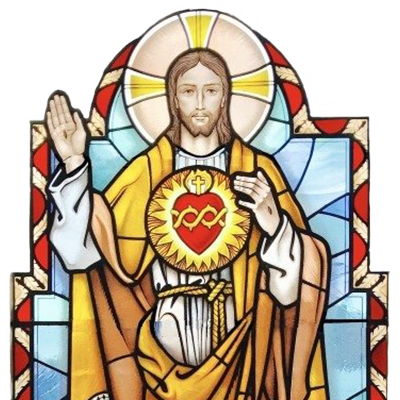ABOUT THE PARISH
The Sacred Heart is a way of describing and talking about the love of God for men and women. While an ancient idea, rooted in scripture, it came to the fore in the nineteenth and twentieth centuries in response to movements that suggested that salvation was difficult and only for the few. The Feast of the Sacred Heart is observed each year on the Friday after Trinity Sunday. The stained glass window above the north entrance to the church shows a traditional depiction of the Sacred Heart.
Churches are important for many Christians, and for Catholics in particular. They are not simply places to meet one another or to pray but are places that represent Jesus, the Son of God, and in which we might meet him. They are both the house of God and the house of the People of God. They are set aside as a place dedicated wholly for the worship of God.
The church building is a reminder of the continuing presence of God amongst his people.
- The most important symbol in the church is the 'altar,' standing at the centre of the church and used only during the celebration of Mass. It is dressed with a white cloth and with candles and contains the relics of a saint. The 'mensa' (top) shows the marks where it was anointed with oil as part of the consecration of the church.
- Behind the altar is the 'tabernacle' containing the 'Blessed Sacrament' – considered to be the “Real Presence” of Jesus. Bread and Wine are consecrated at Mass, become the body and blood of Jesus and are reserved so that 'Holy Communion' can be taken to the sick and dying. Since they are the strongest sign of Jesus, they are always shown the worship (reverence) due to God himself, and this is why Catholics will 'genuflect' (bend a knee) in the church. Near it (on the right hand side of the Sanctuary) burns the red 'Sanctuary Lamp,' which announces God's presence in the sacrament.
- On the rear wall is shown a large image of the Risen Jesus, bearing the wounds of his passion. The depiction of Jesus in priestly robes was common in churches before the Middle Ages.
- The doors of the church are a reminder of Jesus who is the 'Good Shepherd,' “the door through which those who follow him enter and are safe, go in and go out and find good pasture.”
- On the left of the 'sanctuary' is the 'Baptistry,' containing the 'Baptismal Font,' and 'Paschal (Easter) Candle.' It also contains a picture of the baptism of Jesus.
- At the entrance to the church you will find small bowls ('Stoops') containing holy water, as a reminder of the font in which we become Christians by baptism. When coming into church people will put their hand in the water and make the sign of the cross as a reminder of their own baptism.
- The walls of the church carry 12 'Consecration Crosses' – engraved crosses and candle sconces – indicating those places where the walls of the church were anointed during its consecration.
- The 'Stations of the Cross' are used as a form of meditative prayer in which the story of Jesus’ death is remembered. (Pilate condemns Jesus to die; Jesus accepts his cross; Jesus falls for the first time; Jesus meets his mother, Mary; Simon of Cyrene helps Jesus to carry the cross; Veronica
- wipes the face of Jesus; Jesus falls for the second time; Jesus meets the women of Jerusalem; Jesus falls for the third time; Jesus is stripped of his clothes; Jesus is nailed to the cross; Jesus dies on the cross; Jesus is taken down from the cross; Jesus is placed in the tomb.)
- The church contains 3 statues, one of Mary, the Mother of God (front right), one of St Joseph, the spouse of Mary (front left) and St Thomas of Canterbury (at the back right). This latter came from the small Catholic church in Steels Lane, Oxshott (now Canterbury Mews). Mary is important as the Mother of Jesus and also as his first and best disciple.
- On the right hand side of the church are two small rooms set aside for celebrating the 'Sacrament of Reconciliation' (often simply called “confession”) with pictures of the Good Shepherd and the Return of the Prodigal Son etched on the glass of the doors.
Church Architecture
The church was designed by Henry Stuart Goodhart-Rendel (1887-1959), one of England’s most revered 20th century architects.
A multi-talented man, he was a fine musician, architectural critic and wit. From 1933 to 1936 he was Slade Professor of Fine Art at Oxford; in 1936 he was appointed Director of the Architectural Association but left after a year or two; and from 1937 to 1939 he was President of the RIBA.
As an architect he is generally considered most successful as a designer of churches.
.
